All-Sky Imager Observations of the Latitudinal Extent and Zonal Motion of Magnetically Conjugate 630.0 nm Airglow Depletions
Abstract
1. Introduction
2. Observations
2.1. Arecibo ESF Depletions
2.2. Magnetically Conjugate Observations
2.3. Magnetically Conjugate Zonal Velocities
3. Discussion
4. Conclusions
Author Contributions
Funding
Acknowledgments
Conflicts of Interest
References
- Martinis, C.; Baumgardner, J.; Wroten, J.; Mendillo, M. All-sky-imaging capabilities for ionospheric space weather research using geomagnetic conjugate point observing sites. Adv. Space Res. 2018, 61, 1636–1651. [Google Scholar] [CrossRef]
- Hickey, D.A.; Sau, S.; Narayanan, V.L.; Gurubaran, S. A possible explanation of interhemispheric asymmetry of equatorial plasma bubbles in airglow images. J. Geophys. Res. Space 2020, 125, e2019JA027592. [Google Scholar] [CrossRef]
- Bilitza, D.; Altadill, D.; Truhlik, V.; Shubin, V.; Galkin, I.; Reinisch, B.; Huang, X. International reference ionosphere 2016: From ionospheric climate to real-time weather predictions. Space Weather 2017, 15, 418–429. [Google Scholar] [CrossRef]
- Picone, J.M.; Hedin, A.E.; Drob, D.P.; Aikin, A.C. NRLMSISE-00 empirical model of the atmosphere: Statistical comparisons and scientific issues. J. Geophys. Res. 2002, 107, 1468. [Google Scholar] [CrossRef]
- Martinis, C.; Mendillo, M. Equatorial spread F-related airglow depletions at Arecibo and conjugate observations. J. Geophys. Res. 2007, 112, A10310. [Google Scholar] [CrossRef]
- Martinis, C.; Baumgardner, J.; Wroten, J.; Mendillo, M. Seasonal dependence of MSTIDs obtained from 630.0 nm airglow imaging at Arecibo. Geophys. Res. Lett. 2010, 37, L11103. [Google Scholar] [CrossRef]
- Shiokawa, K.; Ihara, C.; Otsuka, Y.; Ogawa, T. Statistical study of nighttime medium-scale traveling ionospheric disturbances using midlatitude airglow images. J. Geophys. Res. 2003, 108, 1052. [Google Scholar] [CrossRef]
- Martinis, C.; Baumgardner, J.; Wroten, J.; Mendillo, M. All-sky imaging observations of conjugate medium-scale traveling ionospheric disturbances in the American sector. J. Geophys. Res. 2011, 116, A05326. [Google Scholar] [CrossRef]
- Aarons, J. The longitudinal morphology of equatorial F-layer irregularities relevant to their occurrence. Space Sci. Rev. 1993, 63, 209–243. [Google Scholar] [CrossRef]
- Burke, W.; Huang, C.; Gentile, L.; Bauer, L. Seasonal-longitudinal variability of equatorial plasma bubbles. Ann. Gepphys. 2004, 22, 3089–3098. [Google Scholar] [CrossRef]
- Aa, E.; Zou, S.; Liu, S. Statistical analysis of equatorial plasma irregularities retrieved from Swarm 2013–2019 observations. J. Geophys. Res. Space 2020, 125, e2019JA027022. [Google Scholar] [CrossRef]
- Martinis, C.; Mendillo, M.; Aarons, J. Toward a synthesis of equatorial spread-F (ESF) onset and suppression during geomagnetic storms. J. Geophys. Res. 2005, 110, A07306. [Google Scholar] [CrossRef]
- Hickey, D.A.; Martinis, C.R.; Mendillo, M.; Baumgardner, J.; Wroten, J.; Milla, M. Simultaneous 6300 Å airglow and radar observations of ionospheric irregularities and dynamics at the geomagnetic equator. Ann. Geophys. 2018, 36, 473–487. [Google Scholar] [CrossRef]
- Martinis, C.; Eccles, J.V.; Baumgardner, J.; Manzano, J.; Mendillo, M. Latitude dependence of zonal plasma drifts obtained from dual-site airglow observations. J. Geophys. Res. 2003, 108, 1129. [Google Scholar] [CrossRef]
- Sobral, J.H.A.; Abdu, M.A.; Pedersen, T.R.; Castilho, V.; Arruda, D.; Muella, M.; Batista, I.; Mascarenhas, M.; de Paula, E.; Kintner, P. Ionospheric zonal velocities at conjugate points over Brazil during the COPEX campaign: Experimental observations and theoretical validations. J. Geophys. Res. 2009, 114, A04309. [Google Scholar] [CrossRef]
- Chapagain, N.P.; Fisher, D.J.; Meriwether, J.W. Comparison of zonal neutral winds with equatorial plasma bubble and plasma drift velocities. J. Geophys. Res. Space Phys. 2013, 118, 1802–1812. [Google Scholar] [CrossRef]
- Fukushima, D.; Shiokawa, K.; Otsuka, Y.; Nishioka, M.; Kubota, M.; Tsugawa, T.; Nagatsuma, T.; Komonjinda, S.; Yatini, C.Y. Geomagnetically conjugate observation of plasma bubbles and thermospheric neutral winds at low latitudes. J. Geophys. Res. Space Phys. 2015, 120, 2222–2231. [Google Scholar] [CrossRef]
- Kelley, M.C.; Makela, J.J.; Paxton, L.J.; Kamalabadi, F.; Comberiate, J.M.; Kil, H. The first coordinated ground- and space-based optical observations of equatorial plasma bubbles. Geophys. Res. Lett. 2003, 30, 1766. [Google Scholar] [CrossRef]
- Otsuka, Y.; Shiokawa, K.; Ogawa, T.; Wilkinson, P. Geomagnetic conjugate observations of equatorial airglow depletions. Geophys. Res. Lett. 2002, 29, 15. [Google Scholar] [CrossRef]
- Abdu, M.A.; Batista, I.S.; Reinisch, B.W.; de Souza, J.R.; Sobral, J.H.A.; Pedersen, T.R.; Medeiros, A.F.; Schuch, N.J.; de Paula, E.R.; Groves, K.M. Conjugate Point Equatorial Experiment (COPEX) campaign in Brazil: Electrodynamics highlights on spread F development conditions and day-to-day variability. J. Geophys. Res. 2009, 114, A04308. [Google Scholar] [CrossRef]
- Ma, G.; Maruyama, T. A super bubble detected by dense GPS network at east Asian longitudes. Geophys. Res. Lett. 2006, 33, L21103. [Google Scholar] [CrossRef]
- Martinis, C.; Baumgardner, J.; Mendillo, M.; Wroten, J.; Coster, A.; Paxton, L. The night when the auroral and equatorial ionospheres converged. J. Geophys. Res. Space Phys. 2015, 120, 8085–8095. [Google Scholar] [CrossRef]
- Aa, E.; Zou, S.; Ridley, A.J.; Zhang, S.; Coster, A.; Erickson, P.; Liu, S.; Ren, J. Merging of storm time midlatitude traveling ionospheric disturbances and equatorial plasma bubbles. Space Weather 2019, 17, 285–298. [Google Scholar] [CrossRef]
- Mendillo, M.; Zesta, E.; Shodhan, S.; Sultan, P. Observations and modeling of the coupled latitude-altitude patterns of equatorial plasma depletions. J. Geophys. Res. 2005, 110, A09303. [Google Scholar] [CrossRef]
- Krall, J.; Huba, J.D.; Martinis, C. Three-dimensional modeling of equatorial spread-F airglow enhancements. Geophys. Res. Lett. 2009, 36, L10103. [Google Scholar] [CrossRef]
- Krall, J.; Huba, J.D.; Ossakow, S.L.; Joyce, G. Why do equatorial ionospheric bubbles stop rising? Geophys. Res. Lett. 2010, 37, L09105. [Google Scholar] [CrossRef]
- Thébault, E.; Finlay, C.C.; Beggan, C.D.; Alken, P.; Aubert, J.; Barrois, O.; Bertrand, F.; Bondar, T.; Boness, A.; Brocco, L. International Geomagnetic Reference Field: The 12th generation. Earth Planets Space 2015, 67, 79. [Google Scholar] [CrossRef]
- Rishbeth, H. Thermospheric winds and the F-region: A review. J. Atmos. Terr. Phys. 1972, 34, 1–47. [Google Scholar] [CrossRef]
- Drob, D.P.; Emmert, J.T.; Meriwether, J.W.; Makela, J.; Doornbos, J.; Conde, M.; Hernandez, G.; Noto, J.; Zawdie, K.A.; McDonald, S.E. An update to the Horizontal Wind Model (HWM): The quiet time thermosphere. Earth Space Sci. 2015, 2, 301–319. [Google Scholar] [CrossRef]
- Laundal, K.M.; Richmond, A.D. Magnetic Coordinate Systems. Space Sci. Rev. 2017, 206, 27–59. [Google Scholar] [CrossRef]



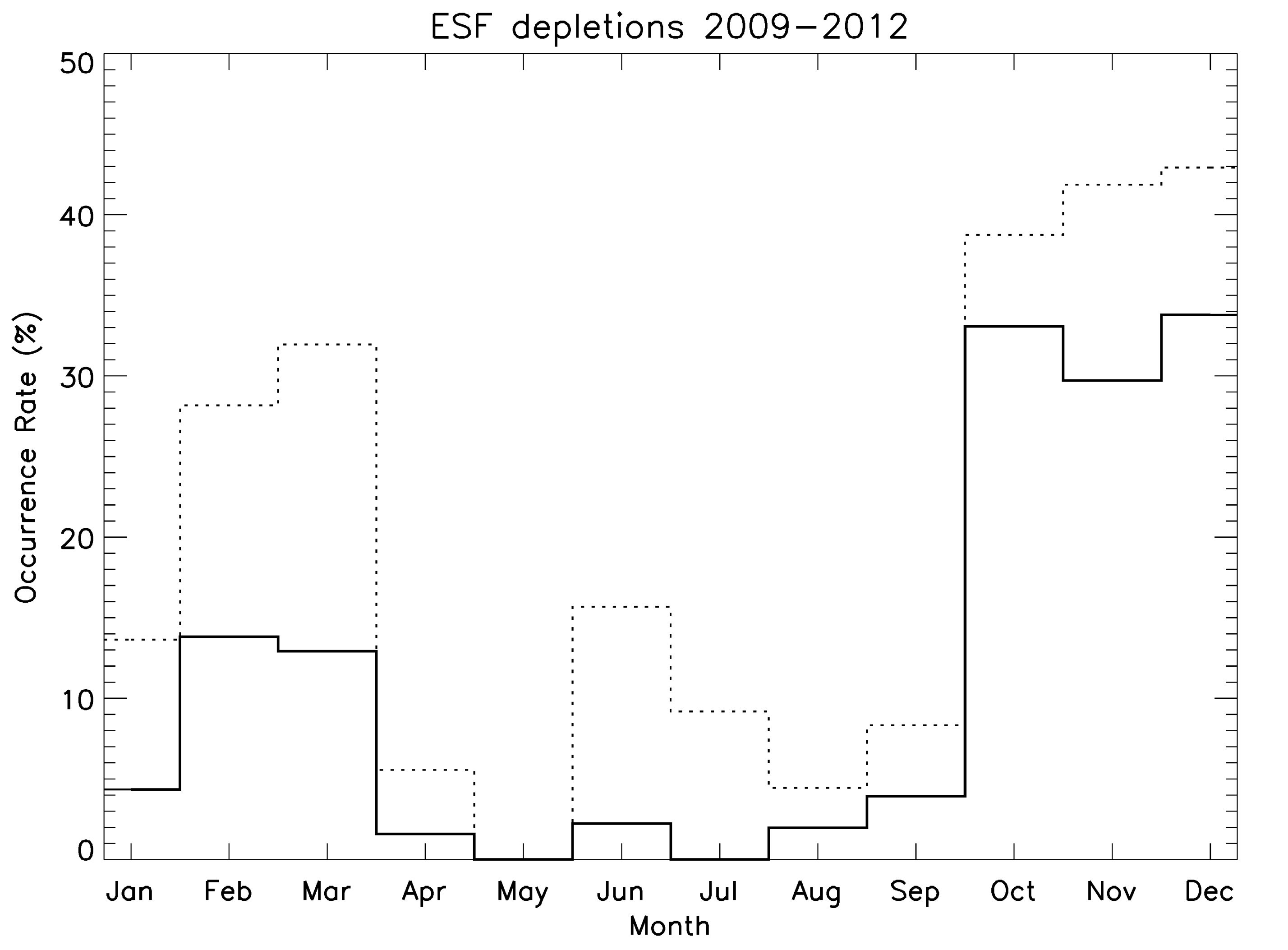
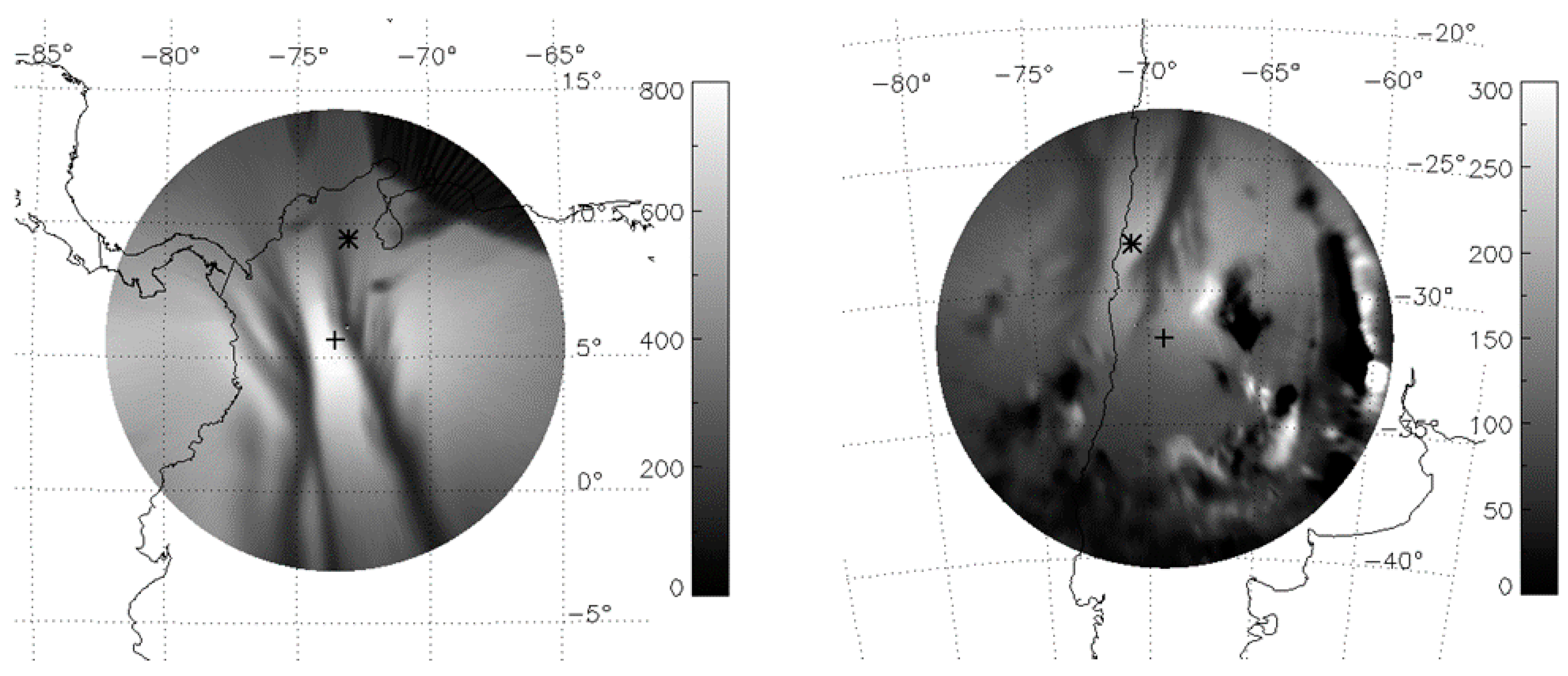



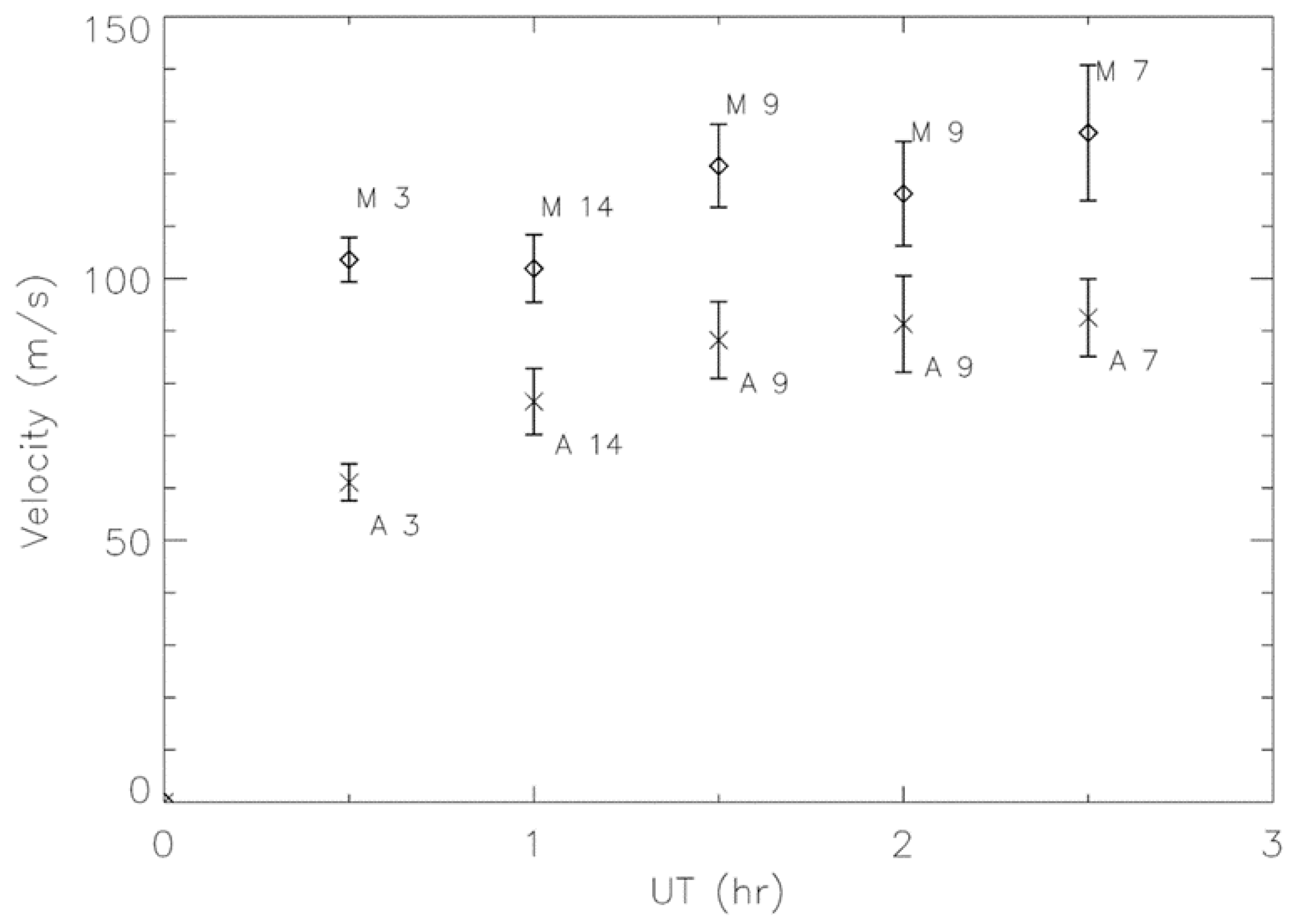
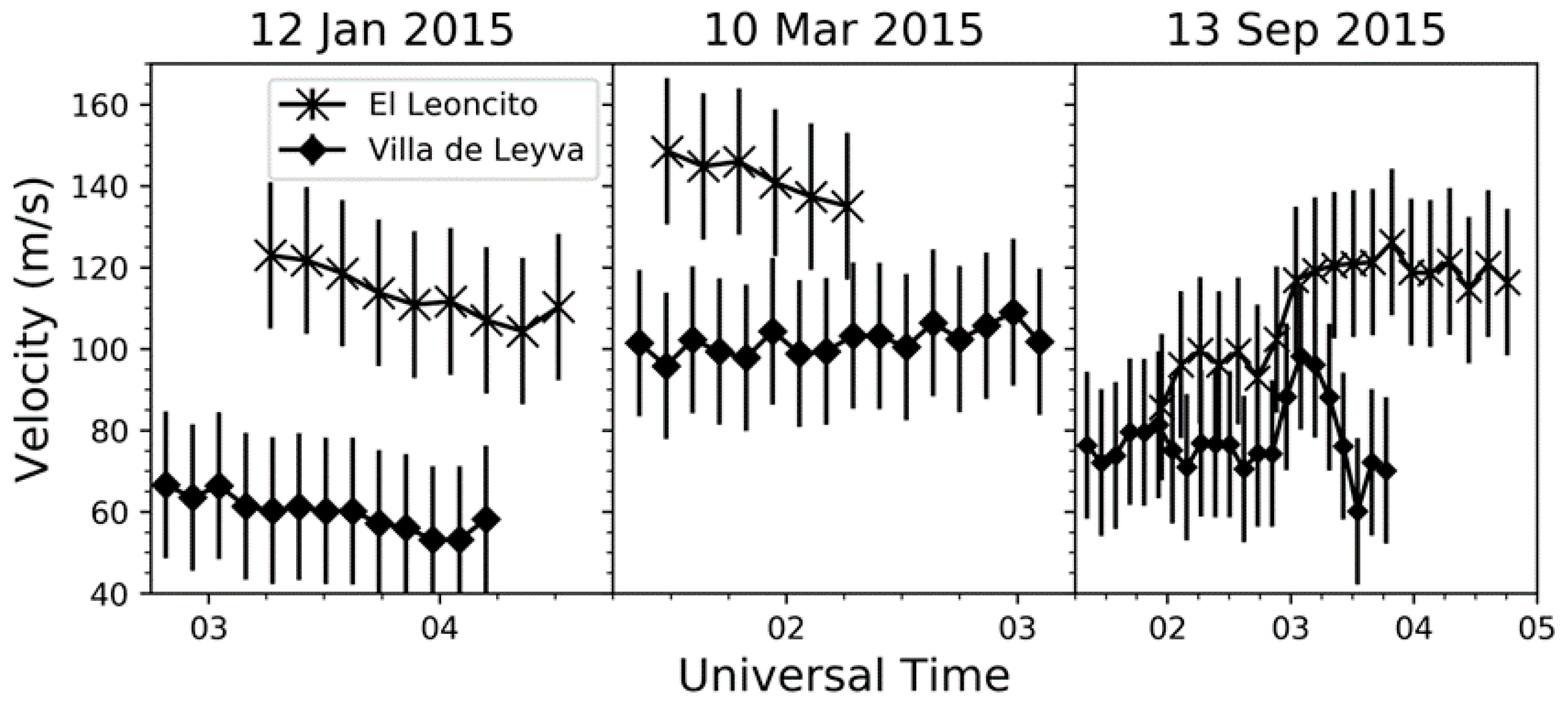
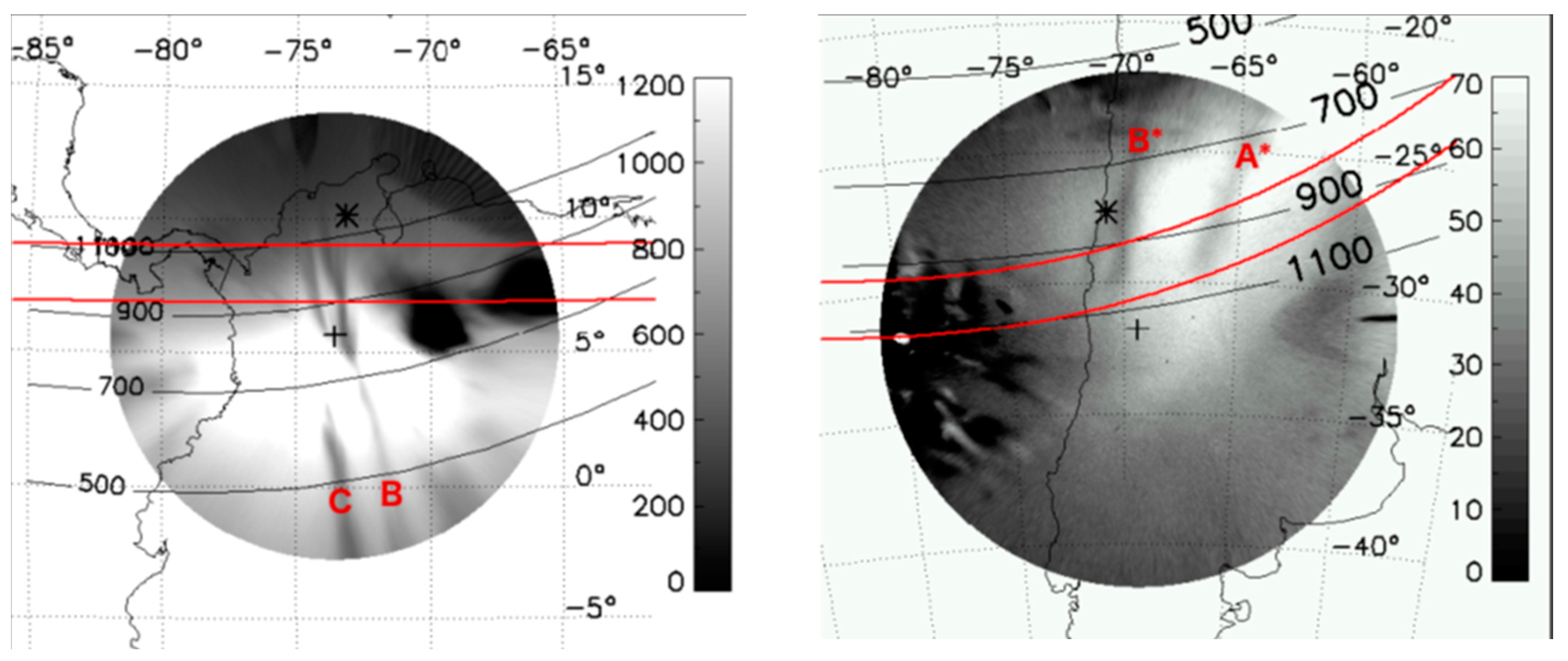

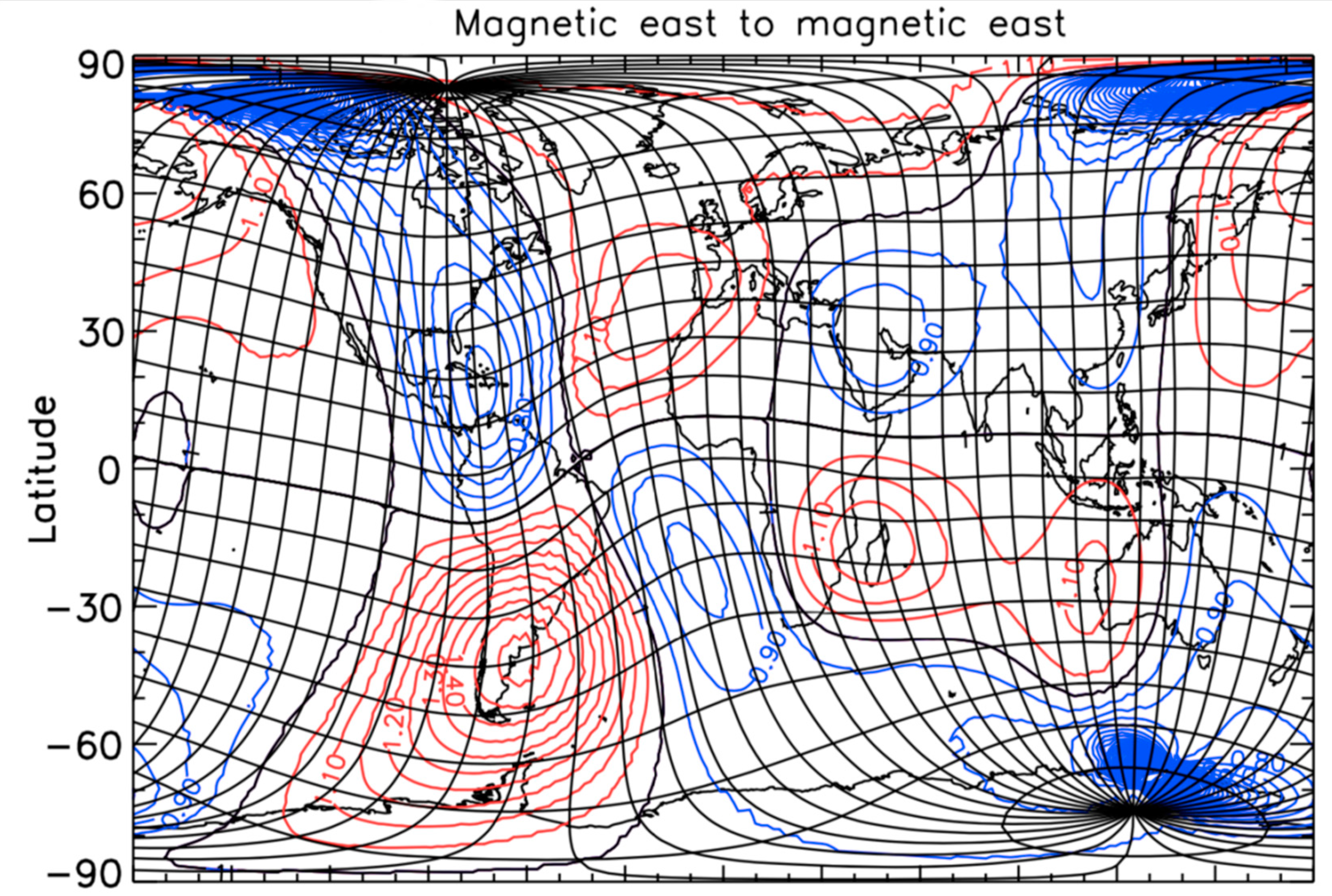
| Year | <F10.7> | # Cases Arecibo | # Cases Mercedes | # Simultaneous |
|---|---|---|---|---|
| 2009 | 69 | 5 | 15 | 3 |
| 2010 | 80 | 13 | 33 | 7 |
| 2011 | 113 | 45 | 67 | 27 |
| January–February 2012 | 113 | 18 | 17 | 14 |
| Total | 81 | 122 | 51 |
© 2020 by the authors. Licensee MDPI, Basel, Switzerland. This article is an open access article distributed under the terms and conditions of the Creative Commons Attribution (CC BY) license (http://creativecommons.org/licenses/by/4.0/).
Share and Cite
Martinis, C.; Hickey, D.; Wroten, J.; Baumgardner, J.; Macinnis, R.; Sullivan, C.; Padilla, S. All-Sky Imager Observations of the Latitudinal Extent and Zonal Motion of Magnetically Conjugate 630.0 nm Airglow Depletions. Atmosphere 2020, 11, 642. https://doi.org/10.3390/atmos11060642
Martinis C, Hickey D, Wroten J, Baumgardner J, Macinnis R, Sullivan C, Padilla S. All-Sky Imager Observations of the Latitudinal Extent and Zonal Motion of Magnetically Conjugate 630.0 nm Airglow Depletions. Atmosphere. 2020; 11(6):642. https://doi.org/10.3390/atmos11060642
Chicago/Turabian StyleMartinis, Carlos, Dustin Hickey, Joei Wroten, Jeffrey Baumgardner, Rebecca Macinnis, Caity Sullivan, and Santiago Padilla. 2020. "All-Sky Imager Observations of the Latitudinal Extent and Zonal Motion of Magnetically Conjugate 630.0 nm Airglow Depletions" Atmosphere 11, no. 6: 642. https://doi.org/10.3390/atmos11060642
APA StyleMartinis, C., Hickey, D., Wroten, J., Baumgardner, J., Macinnis, R., Sullivan, C., & Padilla, S. (2020). All-Sky Imager Observations of the Latitudinal Extent and Zonal Motion of Magnetically Conjugate 630.0 nm Airglow Depletions. Atmosphere, 11(6), 642. https://doi.org/10.3390/atmos11060642





